While returning to London from his Scottish sojourn in 1829, Mendelssohn made an excursion to northern Wales, where he visited the family of John Taylor (1779–1863), an English mining engineer who owned a summer residence in Flintshire. (Taylor’s sister, Sarah Austin, was a member of the circle of Jeremy Bentham and John Stuart Mill, and a productive author and translator of German literature.) Playing the English gentleman, Mendelssohn enjoyed hunting, reading Sir Walter Scott, visiting one of Taylor’s mines, and flirting with his three daughters, for whom the composer produced the
Trois fantaisies ou caprices, Op 16. For Anne, he joined a pensive Andante con moto in A minor, with traces of his Scottish style, to a spirited, A major Allegro vivace meant to capture bouquets of Anne’s favourite roses and carnations, with ascending arpeggiations to suggest the wafting scent. Floral imagery also informed the second caprice, for Honora. This E minor Scherzo is propelled by crisp fanfares and light staccato work to represent a creeping vine with trumpet-shaped flowers. And the third caprice, for Susan, whom Mendelssohn described as the ‘prettiest’, gently traced the course of a meandering rivulet that the two encountered during one of their walks.
from notes by R Larry Todd © 2014
En 1829, son tour d’Écosse achevé, Mendelssohn rentra à Londres, non sans avoir poussé jusque dans le nord du Pays de Galles, où il rendit visite à la famille de l’Anglais John Taylor (1779–1863), un ingénieur des mines propriétaire d’une résidence d’été dans le Flintshire. (La sœur de Taylor, Sarah Austin, était membre du cercle de Jeremy Bentham et de John Stuart Mill; elle était une littératrice prolifique et une traductrice d’auteurs allemands.) Jouant les gentlemen anglais, Mendelssohn aimait à chasser, lire Sir Walter Scott, visiter l’une des mines de John et flirter avec les trois filles Taylor, pour qui il composa les
Trois fantaisies ou caprices, op.16. Pour Anne, il joignit un pensif Andante con moto en la mineur, nué de son style écossais, à un enjoué Allegro vivace en la majeur cherchant à capturer les bouquets de roses et d’œillets préférés de la jeune fille, des arpèges ascendants venant en suggérer le délicieux parfum. Les images florales imprègnent également le deuxième caprice, pour Honora. Ce Scherzo en mi mineur est propulsé par de pimpantes fanfares et par un léger staccato symbolisant une plante grimpante aux fleurs en forme de trompette. Quant au troisième caprice, celui pour Susan—la «plus jolie» selon Mendelssohn—, il dessine doucement le cours d’un ruisselet méandreux rencontré pendant l’une de leurs promenades.
extrait des notes rédigées par R Larry Todd © 2014
Français: Hypérion
Als er 1829 von seinem Aufenthalt in Schottland nach London zurückkehrte, unternahm Mendelssohn einen Ausflug nach Nord-Wales, wo er die Familie von John Taylor (1779–1863) besuchte—Taylor war ein englischer Bergbauingenieur, dem eine Sommerresidenz in Flintshire gehörte. (Taylors Schwester, Sarah Austin, gehörte dem Zirkel um Jeremy Bentham und John Stuart Mill an und war selbst eine produktive Autorin und Übersetzerin deutscher Literatur.) Mendelssohn spielte den englischen Gentleman, vergnügte sich auf der Jagd, las Sir Walter Scott, besuchte eine von Taylors Minen und flirtete mit seinen drei Töchtern, für die er die
Trois fantaisies ou caprices, op. 16 komponierte. Für Anne kombinierte er ein nachdenkliches Andante con moto in a-Moll, das Spuren seines schottischen Stils enthält, mit einem lebhaften Allegro vivace in A-Dur, das Sträuße von Annes Lieblingsblumen, Rosen und Nelken, darstellen soll, wobei die aufsteigenden Arpeggierungen den emporströmenden Blumenduft andeuten. Blumige Metaphorik findet sich auch im zweiten Caprice, welches Honora gewidmet ist. Dieses Scherzo in e-Moll wird von frischen fanfarenartigen Figuren und leichtem Staccato vorangetrieben, womit eine sich windende Kletterpflanze mit trompetenförmigen Blüten dargestellt wird. Und das dritte Caprice für Susan, die Mendelssohn als die „Hübscheste“ beschrieb, zeichnet den Verlauf eines sich entlangschlängelnden Baches nach, auf den die beiden auf einem ihrer Spaziergänge getroffen waren.
aus dem Begleittext von R Larry Todd © 2014
Deutsch: Viola Scheffel


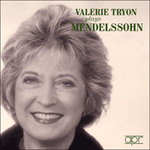 Mendelssohn: Valerie Tryon plays Mendelssohn
Mendelssohn: Valerie Tryon plays Mendelssohn BBC Music Magazine» More
BBC Music Magazine» More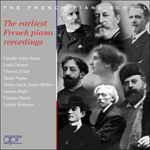 The earliest French piano recordings
The earliest French piano recordings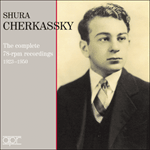 Shura Cherkassky - The complete 78-rpm recordings, 1923-1950
Shura Cherkassky - The complete 78-rpm recordings, 1923-1950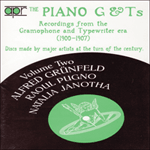 The Piano G & Ts, Vol. 2 - Alfred Grünfeld, Raoul Pugno & Natalia Janotha
The Piano G & Ts, Vol. 2 - Alfred Grünfeld, Raoul Pugno & Natalia Janotha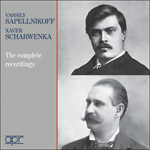 Vassily Sapellnikoff & Xaver Scharwenka - The complete recordings
Vassily Sapellnikoff & Xaver Scharwenka - The complete recordings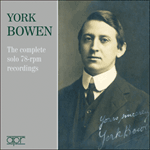 York Bowen - The complete solo 78-rpm recordings
York Bowen - The complete solo 78-rpm recordings
